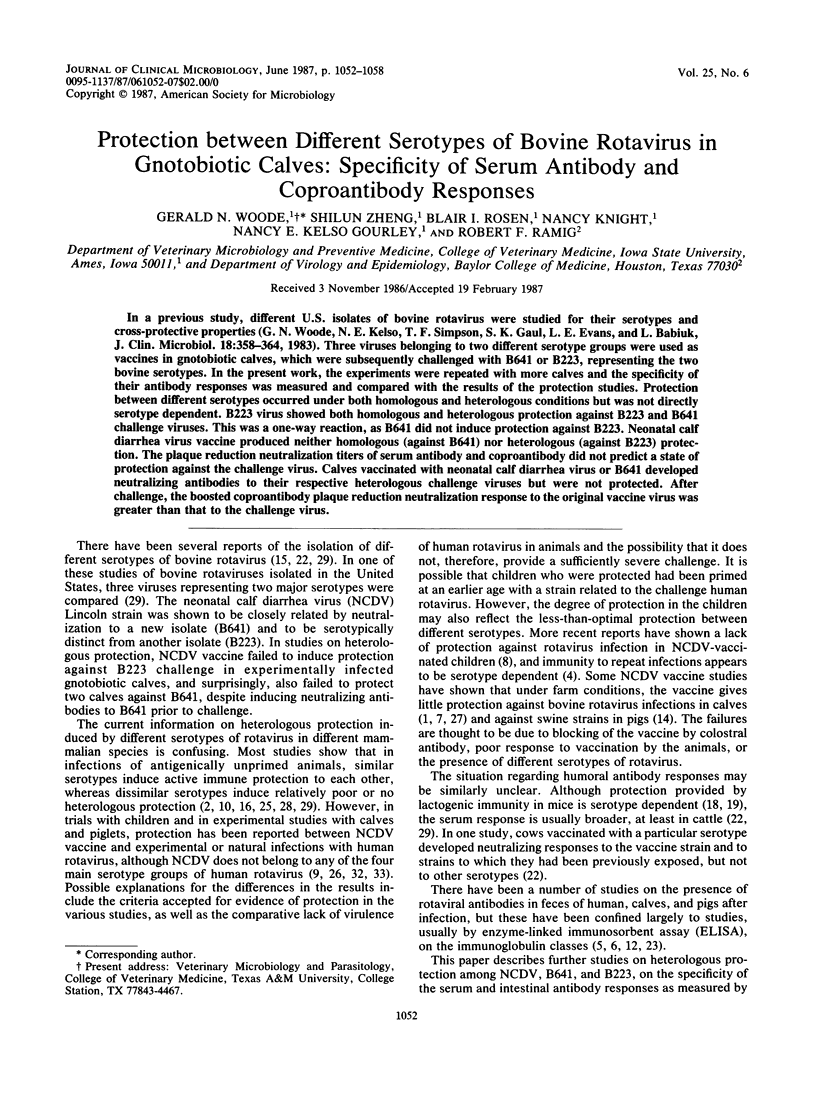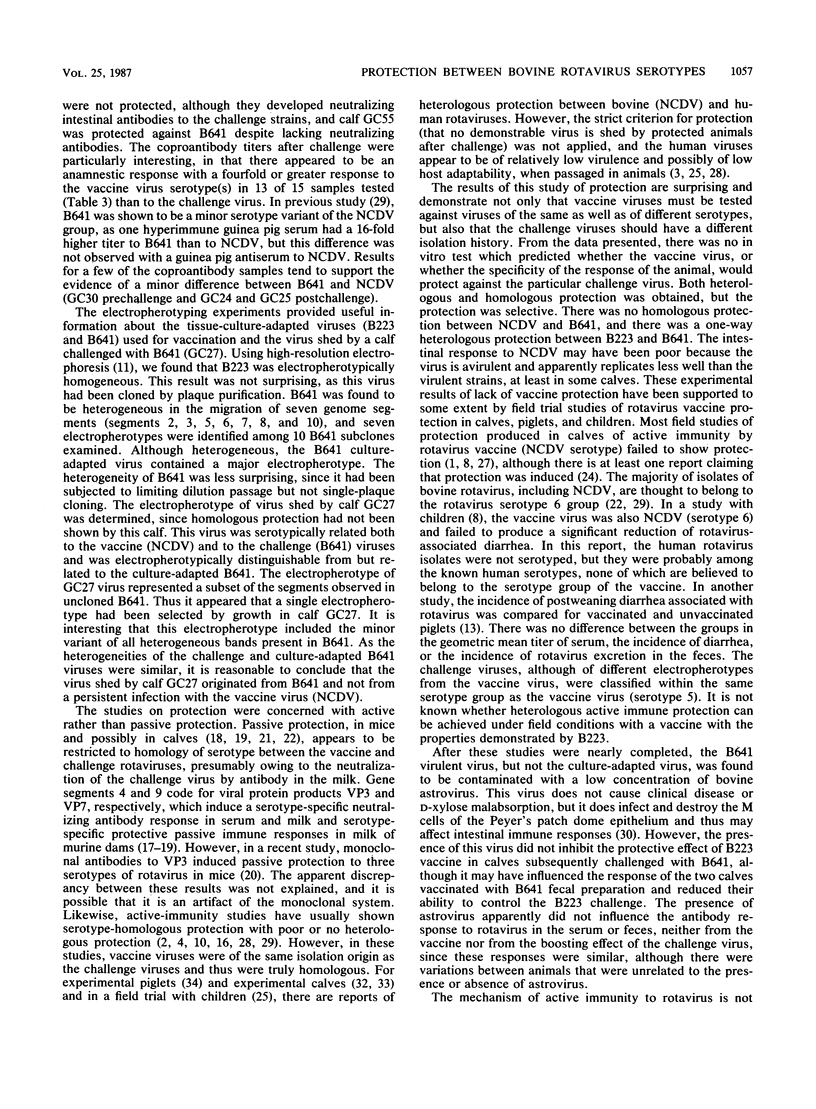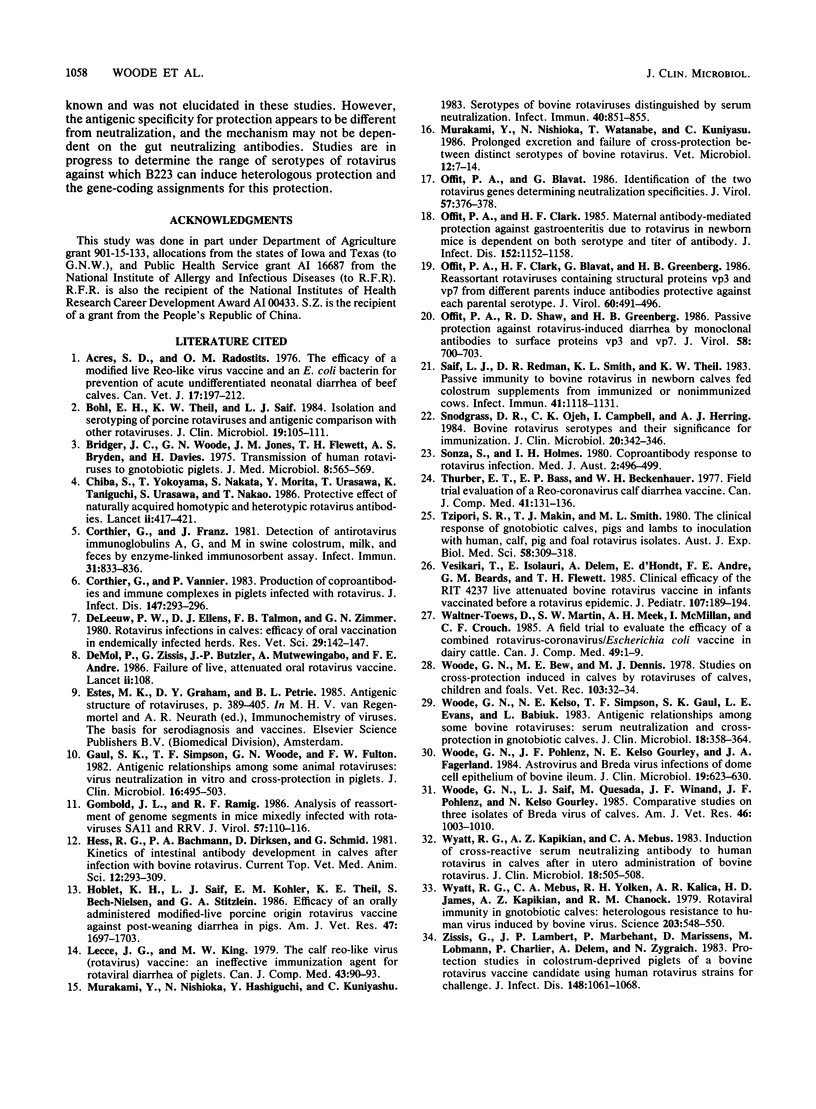Abstract
In a previous study, different U.S. isolates of bovine rotavirus were studied for their serotypes and cross-protective properties (G. N. Woode, N. E. Kelso, T. F. Simpson, S. K. Gaul, L. E. Evans, and L. Babiuk, J. Clin. Microbiol. 18:358-364, 1983). Three viruses belonging to two different serotype groups were used as vaccines in gnotobiotic calves, which were subsequently challenged with B641 or B223, representing the two bovine serotypes. In the present work, the experiments were repeated with more calves and the specificity of their antibody responses was measured and compared with the results of the protection studies. Protection between different serotypes occurred under both homologous and heterologous conditions but was not directly serotype dependent. B223 virus showed both homologous and heterologous protection against B223 and B641 challenge viruses. This was a one-way reaction, as B641 did not induce protection against B223. Neonatal calf diarrhea virus vaccine produced neither homologous (against B641) nor heterologous (against B223) protection. The plaque reduction neutralization titers of serum antibody and coproantibody did not predict a state of protection against the challenge virus. Calves vaccinated with neonatal calf diarrhea virus or B641 developed neutralizing antibodies to their respective heterologous challenge viruses but were not protected. After challenge, the boosted coproantibody plaque reduction neutralization response to the original vaccine virus was greater than that to the challenge virus.
Full text
PDF






Images in this article
Selected References
These references are in PubMed. This may not be the complete list of references from this article.
- Acres S. D., Radostits O. M. The efficacy of a modified live reo-like virus vaccine and an E. coli bacterin for prevention of acute undifferentiated neonatal diarrhea of beef calves. Can Vet J. 1976 Aug;17(8):197–212. [PMC free article] [PubMed] [Google Scholar]
- Bohl E. H., Theil K. W., Saif L. J. Isolation and serotyping of porcine rotaviruses and antigenic comparison with other rotaviruses. J Clin Microbiol. 1984 Feb;19(2):105–111. doi: 10.1128/jcm.19.2.105-111.1984. [DOI] [PMC free article] [PubMed] [Google Scholar]
- Bridger J. C., Woode G. N., Jones J. M., Flewett T. H., Bryden A. S., Davies H. Transmission of human rotaviruses to gnotobiotic piglets. J Med Microbiol. 1975 Nov;8(4):565–569. doi: 10.1099/00222615-8-4-565. [DOI] [PubMed] [Google Scholar]
- Chiba S., Yokoyama T., Nakata S., Morita Y., Urasawa T., Taniguchi K., Urasawa S., Nakao T. Protective effect of naturally acquired homotypic and heterotypic rotavirus antibodies. Lancet. 1986 Aug 23;2(8504):417–421. doi: 10.1016/s0140-6736(86)92133-1. [DOI] [PubMed] [Google Scholar]
- Corthier G., Franz J. Detection of antirotavirus immunoglobulins A, G, and M in swine colostrum, milk, and feces by enzyme-linked immunosorbent assay. Infect Immun. 1981 Feb;31(2):833–836. doi: 10.1128/iai.31.2.833-836.1981. [DOI] [PMC free article] [PubMed] [Google Scholar]
- Corthier G., Vannier P. Production of coproantibodies and immune complexes in piglets infected with rotavirus. J Infect Dis. 1983 Feb;147(2):293–296. doi: 10.1093/infdis/147.2.293. [DOI] [PubMed] [Google Scholar]
- De Mol P., Zissis G., Butzler J. P., Mutwewingabo A., André F. E. Failure of live, attenuated oral rotavirus vaccine. Lancet. 1986 Jul 12;2(8498):108–108. doi: 10.1016/s0140-6736(86)91643-0. [DOI] [PubMed] [Google Scholar]
- Gaul S. K., Simpson T. F., Woode G. N., Fulton R. W. Antigenic relationships among some animal rotaviruses: virus neutralization in vitro and cross-protection in piglets. J Clin Microbiol. 1982 Sep;16(3):495–503. doi: 10.1128/jcm.16.3.495-503.1982. [DOI] [PMC free article] [PubMed] [Google Scholar]
- Gombold J. L., Ramig R. F. Analysis of reassortment of genome segments in mice mixedly infected with rotaviruses SA11 and RRV. J Virol. 1986 Jan;57(1):110–116. doi: 10.1128/jvi.57.1.110-116.1986. [DOI] [PMC free article] [PubMed] [Google Scholar]
- Hoblet K. H., Saif L. J., Kohler E. M., Theil K. W., Bech-Nielsen S., Stitzlein G. A. Efficacy of an orally administered modified-live porcine-origin rotavirus vaccine against postweaning diarrhea in pigs. Am J Vet Res. 1986 Aug;47(8):1697–1703. [PubMed] [Google Scholar]
- Lecce J. G., King M. W. The calf reo-like virus (rotavirus) vaccine: an ineffective immunization agent for rotaviral diarrhea of piglets. Can J Comp Med. 1979 Jan;43(1):90–93. [PMC free article] [PubMed] [Google Scholar]
- Murakami Y., Nishioka N., Hashiguchi Y., Kuniyasu C. Serotypes of bovine rotaviruses distinguished by serum neutralization. Infect Immun. 1983 Jun;40(3):851–855. doi: 10.1128/iai.40.3.851-855.1983. [DOI] [PMC free article] [PubMed] [Google Scholar]
- Murakami Y., Nishioka N., Watanabe T., Kuniyasu C. Prolonged excretion and failure of cross-protection between distinct serotypes of bovine rotavirus. Vet Microbiol. 1986 Jun;12(1):7–14. doi: 10.1016/0378-1135(86)90036-2. [DOI] [PubMed] [Google Scholar]
- Offit P. A., Blavat G. Identification of the two rotavirus genes determining neutralization specificities. J Virol. 1986 Jan;57(1):376–378. doi: 10.1128/jvi.57.1.376-378.1986. [DOI] [PMC free article] [PubMed] [Google Scholar]
- Offit P. A., Clark H. F., Blavat G., Greenberg H. B. Reassortant rotaviruses containing structural proteins vp3 and vp7 from different parents induce antibodies protective against each parental serotype. J Virol. 1986 Nov;60(2):491–496. doi: 10.1128/jvi.60.2.491-496.1986. [DOI] [PMC free article] [PubMed] [Google Scholar]
- Offit P. A., Clark H. F. Maternal antibody-mediated protection against gastroenteritis due to rotavirus in newborn mice is dependent on both serotype and titer of antibody. J Infect Dis. 1985 Dec;152(6):1152–1158. doi: 10.1093/infdis/152.6.1152. [DOI] [PubMed] [Google Scholar]
- Offit P. A., Shaw R. D., Greenberg H. B. Passive protection against rotavirus-induced diarrhea by monoclonal antibodies to surface proteins vp3 and vp7. J Virol. 1986 May;58(2):700–703. doi: 10.1128/jvi.58.2.700-703.1986. [DOI] [PMC free article] [PubMed] [Google Scholar]
- Saif L. J., Redman D. R., Smith K. L., Theil K. W. Passive immunity to bovine rotavirus in newborn calves fed colostrum supplements from immunized or nonimmunized cows. Infect Immun. 1983 Sep;41(3):1118–1131. doi: 10.1128/iai.41.3.1118-1131.1983. [DOI] [PMC free article] [PubMed] [Google Scholar]
- Snodgrass D. R., Ojeh C. K., Campbell I., Herring A. J. Bovine rotavirus serotypes and their significance for immunization. J Clin Microbiol. 1984 Sep;20(3):342–346. doi: 10.1128/jcm.20.3.342-346.1984. [DOI] [PMC free article] [PubMed] [Google Scholar]
- Sonza S., Holmes I. H. Coproantibody response to rotavirus infection. Med J Aust. 1980 Nov 1;2(9):496–499. doi: 10.5694/j.1326-5377.1980.tb100710.x. [DOI] [PubMed] [Google Scholar]
- Thurber E. T., Bass E. P., Beckenhauer W. H. Field trial evaluation of a reo-coronavirus calf diarrhea vaccine. Can J Comp Med. 1977 Apr;41(2):131–136. [PMC free article] [PubMed] [Google Scholar]
- Tzipori S. R., Makin T. J., Smith M. L. The clinical response of gnotobiotic calves, pigs and lambs to inoculation with human, calf, pig and foal rotavirus isolates. Aust J Exp Biol Med Sci. 1980 Jun;58(3):309–318. doi: 10.1038/icb.1980.31. [DOI] [PubMed] [Google Scholar]
- Vesikari T., Isolauri E., Delem A., d'Hondt E., André F. E., Beards G. M., Flewett T. H. Clinical efficacy of the RIT 4237 live attenuated bovine rotavirus vaccine in infants vaccinated before a rotavirus epidemic. J Pediatr. 1985 Aug;107(2):189–194. doi: 10.1016/s0022-3476(85)80123-2. [DOI] [PubMed] [Google Scholar]
- Waltner-Toews D., Martin S. W., Meek A. H., McMillan I., Crouch C. F. A field trial to evaluate the efficacy of a combined rotavirus-coronavirus/Escherichia coli vaccine in dairy cattle. Can J Comp Med. 1985 Jan;49(1):1–9. [PMC free article] [PubMed] [Google Scholar]
- Woode G. N., Bew M. E., Dennis M. J. Studies on cross protection induced in calves by rotaviruses of calves, children and foals. Vet Rec. 1978 Jul 8;103(2):32–34. doi: 10.1136/vr.103.2.32. [DOI] [PubMed] [Google Scholar]
- Woode G. N., Kelso N. E., Simpson T. F., Gaul S. K., Evans L. E., Babiuk L. Antigenic relationships among some bovine rotaviruses: serum neutralization and cross-protection in gnotobiotic calves. J Clin Microbiol. 1983 Aug;18(2):358–364. doi: 10.1128/jcm.18.2.358-364.1983. [DOI] [PMC free article] [PubMed] [Google Scholar]
- Woode G. N., Pohlenz J. F., Gourley N. E., Fagerland J. A. Astrovirus and Breda virus infections of dome cell epithelium of bovine ileum. J Clin Microbiol. 1984 May;19(5):623–630. doi: 10.1128/jcm.19.5.623-630.1984. [DOI] [PMC free article] [PubMed] [Google Scholar]
- Woode G. N., Saif L. J., Quesada M., Winand N. J., Pohlenz J. F., Gourley N. K. Comparative studies on three isolates of Breda virus of calves. Am J Vet Res. 1985 May;46(5):1003–1010. [PubMed] [Google Scholar]
- Wyatt R. G., Kapikian A. Z., Mebus C. A. Induction of cross-reactive serum neutralizing antibody to human rotavirus in calves after in utero administration of bovine rotavirus. J Clin Microbiol. 1983 Sep;18(3):505–508. doi: 10.1128/jcm.18.3.505-508.1983. [DOI] [PMC free article] [PubMed] [Google Scholar]
- Wyatt R. G., Mebus C. A., Yolken R. H., Kalica A. R., James H. D., Jr, Kapikian A. Z., Chanock R. M. Rotaviral immunity in gnotobiotic calves: heterologous resistance to human virus induced by bovine virus. Science. 1979 Feb 9;203(4380):548–550. doi: 10.1126/science.216077. [DOI] [PubMed] [Google Scholar]
- Zissis G., Lambert J. P., Marbehant P., Marissens D., Lobmann M., Charlier P., Delem A., Zygraich N. Protection studies in colostrum-deprived piglets of a bovine rotavirus vaccine candidate using human rotavirus strains for challenge. J Infect Dis. 1983 Dec;148(6):1061–1068. doi: 10.1093/infdis/148.6.1061. [DOI] [PubMed] [Google Scholar]
- de Leeuw P. W., Ellens D. J., Talmon F. P., Zimmer G. N., Kommerij R. Rotavirus infections in calves: efficacy of oral vaccination in endemically infected herds. Res Vet Sci. 1980 Sep;29(2):142–147. doi: 10.1016/S0034-5288(18)32654-7. [DOI] [PMC free article] [PubMed] [Google Scholar]



